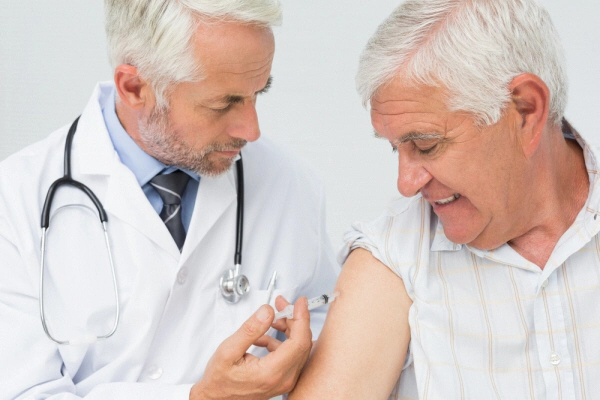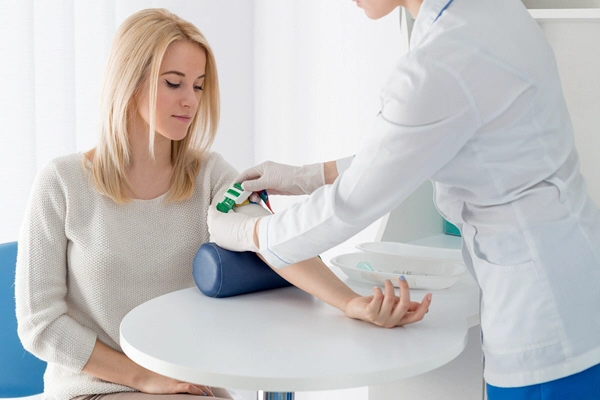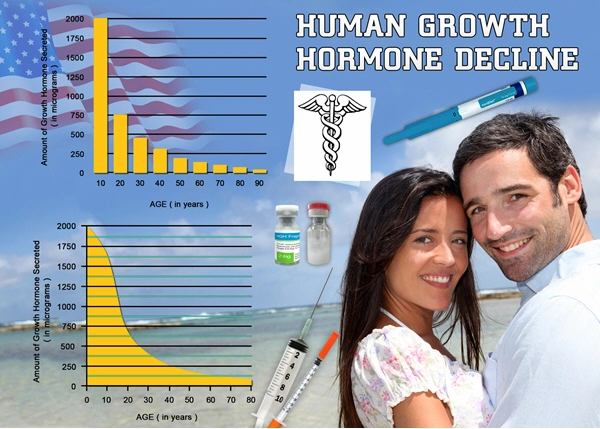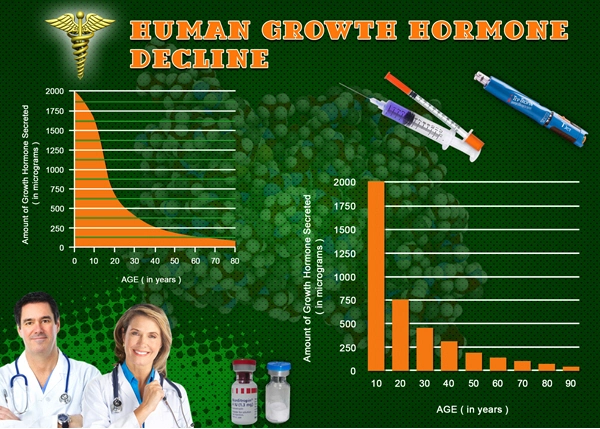Somatotropic cells in the anterior pituitary gland produce the single-chain polypeptide known as human growth hormone (HGH), sometimes referred to as somatotropin, which has 191 amino acids. As its name suggests, scientists originally learned that it regulates development throughout childhood. However, research found that HGH also functions as an acute phase stress reactant and is crucial for controlling many other basic metabolic processes in the body.
The principles of HGH, including its production, regulation, and effects on athletic performance and aging, are explored in this paper.
Introduction:
The anterior pituitary produces human growth hormone in the brain's acidophilic, somatotrophic cells. Numerous intricate feedback mechanisms that react to stress, exercise, food, sleep, and growth hormone itself tightly regulate its production. The brain produces GHRH (growth hormone-releasing hormone), somatostatin is made in a variety of bodily tissues, and ghrelin is made in the digestive tract.
Nowadays, there aren't many guys who still believe in healing waters, yet it seems like there are still plenty that do. To stop time from moving forward, they inject human growth hormone rather than sip rejuvenating fluids. Some are motivated by the claims made by the "anti-aging" movement, while others are motivated by the examples of young athletes seeking an edge in competition.
Biosynthesis of HGH:
From the anterior pituitary somatotroph cells, GH is pulsatilely produced. The main release regulators are somatostatin (negative regulation) and growth hormone-releasing hormone (GHRH; positive regulation) from the hypothalamus.8 The human growth hormone peptides interact with the G protein-coupled receptor (GHRHR) in somatotroph cells, activating the cAMP signaling cascade and boosting the synthesis and release of GH mRNA. Pit-1, a POU homeodomain transcription factor that is exclusive to the pituitary, is stimulated by GHRH, and this in turn increases the transcription of the GH1, GHRHR, and Pit-1 genes (auto-upregulation). As a result of extracellular Ca2+ influx, GHRHR signaling activation in somatotroph cells also results in the release of GH from secretory vesicles.
The main function of GH is to promote postnatal long-term development. It affects the metabolism of lipids, carbohydrates, nitrogen, and minerals as well as the electrolyte balance, and encourages the creation of bones. It encourages adipocyte lipolysis, which lowers body fat, and it encourages muscle amino acid uptake and nitrogen retention, which maintains muscle mass and strength. [1]
Metabolic Effects of HGH:
Increased insulin-like growth factor-1 production and its subsequent impact on peripheral cells are two ways that HGH influences metabolism. As was already said, the activation of intracellular signaling significantly affects the fundamental metabolic functions of organ tissues. Cells often reach an anabolic protein state, which is characterized by an increase in amino acid uptake, protein synthesis, and a decrease in protein catabolism. Adipocytes are encouraged to process and use lipids by stimulating triglyceride oxidation and breakdown. Additionally, HGH accelerates gluconeogenesis in the liver and reduces insulin's ability to stimulate glucose absorption in peripheral tissues, creating a hyperglycemic environment all around. [2]
Regulation of HGH Secretion:
GH secretion is inhibited by SRLs, dopamine antagonists, and GHRH antagonists. To stop the pituitary gland from releasing GH, SRLs attach to somatostatin receptors that are present in tumors. These inhibitors include the second-generation SRLs pasireotide, octreolin, and somatoprim, as well as the first- and second-generation SRLs octreotide and lanreotide. These days, SRLs are used to treat neuroendocrine tumors and acromegaly. Other applications include cancer, diabetes, and obesity.
human growth hormone peptides analog antagonists have been produced by several laboratories. Particularly, the work of Schally et al. has produced several well-characterized inhibitors. GHRH and GHRH receptors are expressed by many tumor tissues and cancer cells. GHRH antagonists inhibit the growth of xenograft tumors and a variety of cancer cell lines in vitro, suggesting that they may have therapeutic benefits. GHRH antagonists, like SRLs, to varying degrees reduce GH endocrine output from the anterior pituitary. However, blocking GHRH receptors in tumor tissues is the main purpose of these antagonists. Potential applications outside of cancer include nephropathy, diabetic retinopathy, and acromegaly. [3]
Enhancing Athletic Performance: The Therapeutic Uses of HGH
Turner's syndrome in females and hGH deficiency in both children and adults are all treated with human growth hormone. High doses of hGH are used to treat thermal injuries such as excessive burns.
Nevertheless, Takala et al. showed that relative to placebo, giving supraphysiological doses of GH to critically ill patients increased mortality. Since the late 1950s, hGH produced from cadaver pituitary glands has been used to treat children with GH insufficiency. Adult hGH deficiency has only lately been acknowledged as a clinical issue and investigated in clinical trials due to the increased accessibility of rhGH. 1989 saw the publication of two significant studies showing the beneficial effects of GH treatment on body composition and metabolism in GH-deficient persons. [4]
44 excellent publications on growth hormone in athletes were thoroughly examined by a group of experts from California. The participants were young (average age 27), slim (BMI 24), and in good physical shape; 85% were male. 303 participants received injections of GH, whereas 137 received a placebo.
After receiving daily injections for an average of 20 days, the patients who received GH saw an average rise in lean body mass—a measure of muscle gain that can also include fluid mass—of 4.6 pounds. Despite being a large increase, it did not result in improved performance. [5]
The Role of Human Growth Hormone in Anti-Aging:
Growth hormone (GH) is effective in boosting lean body mass and lowering body fat in healthy older people, according to a review of 31 studies. However, it is important to emphasize the side effects of human growth hormone might have side effects and that further research is required to ensure its long-term safety.
Human Growth Hormone therapy can assist older people in maintaining a healthy body composition by boosting muscle mass and reducing fat mass. Better physical health, strength, and general quality of life may arise from this.
Conclusion:
Human growth hormone (HGH) is a vital hormone that controls metabolism, many physiological processes, and development throughout life. This leads to better athletic performance and healthy aging. Although human growth hormone therapy has been proven to be useful in many therapeutic contexts, abusing it poses serious health risks. Therefore, it is essential to use HGH only as directed by qualified healthcare professionals and for legitimate medical needs.

- Human Growth Hormone Injections In Cheyenne [Last Updated On: February 3rd, 2025] [Originally Added On: October 19th, 2018]
- Human Growth Hormone Injections In Madison [Last Updated On: February 9th, 2025] [Originally Added On: October 19th, 2018]
- Human Growth Hormone Injections In Vancouver [Last Updated On: February 24th, 2025] [Originally Added On: October 19th, 2018]
- Human Growth Hormone Injections In Tacoma [Last Updated On: February 25th, 2025] [Originally Added On: October 19th, 2018]
- Human Growth Hormone Injections In Spokane [Last Updated On: February 26th, 2025] [Originally Added On: October 19th, 2018]
- Human Growth Hormone Injections In Bellevue [Last Updated On: February 26th, 2025] [Originally Added On: October 19th, 2018]
- Human Growth Hormone Injections In Richmond [Last Updated On: February 9th, 2025] [Originally Added On: October 19th, 2018]
- Human Growth Hormone Injections In Portsmouth [Last Updated On: February 10th, 2025] [Originally Added On: October 19th, 2018]
- Human Growth Hormone Injections In Norfolk [Last Updated On: February 10th, 2025] [Originally Added On: October 19th, 2018]
- Human Growth Hormone Injections In Hampton [Last Updated On: March 27th, 2025] [Originally Added On: October 19th, 2018]
- Human Growth Hormone Injections In Chesapeake [Last Updated On: March 27th, 2025] [Originally Added On: October 19th, 2018]
- Human Growth Hormone Injections In Alexandria [Last Updated On: March 28th, 2025] [Originally Added On: October 19th, 2018]
- Human Growth Hormone Injections In Montpelier [Last Updated On: February 11th, 2025] [Originally Added On: October 19th, 2018]
- Human Growth Hormone Injections In Provo [Last Updated On: February 11th, 2025] [Originally Added On: October 19th, 2018]
- Human Growth Hormone Injections In Waco [Last Updated On: February 16th, 2025] [Originally Added On: October 19th, 2018]
- Human Growth Hormone Injections In Richardson [Last Updated On: February 14th, 2025] [Originally Added On: October 19th, 2018]
- Human Growth Hormone Injections In Plano [Last Updated On: February 15th, 2025] [Originally Added On: October 19th, 2018]
- Human Growth Hormone Injections In Pasadena [Last Updated On: February 13th, 2025] [Originally Added On: October 19th, 2018]
- Human Growth Hormone Injections In Midland [Last Updated On: February 16th, 2025] [Originally Added On: October 19th, 2018]
- Human Growth Hormone Injections In Mesquite [Last Updated On: February 13th, 2025] [Originally Added On: October 19th, 2018]
- Human Growth Hormone Injections In McKinney [Last Updated On: February 12th, 2025] [Originally Added On: October 19th, 2018]
- Human Growth Hormone Injections In McAllen [Last Updated On: February 17th, 2025] [Originally Added On: October 19th, 2018]
- Human Growth Hormone Injections In Lubbock [Last Updated On: February 15th, 2025] [Originally Added On: October 19th, 2018]
- Human Growth Hormone Injections In Lewisville [Last Updated On: February 14th, 2025] [Originally Added On: October 20th, 2018]
- Human Growth Hormone Injections In Laredo [Last Updated On: February 12th, 2025] [Originally Added On: October 20th, 2018]
- Human Growth Hormone Injections In Killeen [Last Updated On: February 18th, 2025] [Originally Added On: October 20th, 2018]
- Human Growth Hormone Injections In Irving [Last Updated On: February 19th, 2025] [Originally Added On: October 20th, 2018]
- Human Growth Hormone Injections In Garland [Last Updated On: February 20th, 2025] [Originally Added On: October 20th, 2018]
- Human Growth Hormone Injections In Denton [Last Updated On: February 21st, 2025] [Originally Added On: October 20th, 2018]
- Human Growth Hormone Injections In Carrollton [Last Updated On: February 17th, 2025] [Originally Added On: October 20th, 2018]
- Human Growth Hormone Injections In Brownsville [Last Updated On: February 21st, 2025] [Originally Added On: October 20th, 2018]
- Human Growth Hormone Injections In Beaumont [Last Updated On: February 18th, 2025] [Originally Added On: October 20th, 2018]
- Human Growth Hormone Injections In Austin [Last Updated On: February 22nd, 2025] [Originally Added On: October 20th, 2018]
- Human Growth Hormone Injections In Arlington [Last Updated On: February 20th, 2025] [Originally Added On: October 20th, 2018]
- Human Growth Hormone Injections In Amarillo [Last Updated On: February 19th, 2025] [Originally Added On: October 20th, 2018]
- Human Growth Hormone Injections In Abilene [Last Updated On: February 22nd, 2025] [Originally Added On: October 20th, 2018]
- Human Growth Hormone Injections In Nashville [Last Updated On: February 27th, 2025] [Originally Added On: October 20th, 2018]
- Human Growth Hormone Injections In Murfreesboro [Last Updated On: February 27th, 2025] [Originally Added On: October 20th, 2018]
- Human Growth Hormone Injections In Memphis [Last Updated On: February 28th, 2025] [Originally Added On: October 20th, 2018]
- Human Growth Hormone Injections In Knoxville [Last Updated On: February 28th, 2025] [Originally Added On: October 20th, 2018]
- Human Growth Hormone Injections In Clarksville [Last Updated On: March 1st, 2025] [Originally Added On: October 20th, 2018]
- Human Growth Hormone Injections In Chattanooga [Last Updated On: March 1st, 2025] [Originally Added On: October 20th, 2018]
- Human Growth Hormone Injections In Erie [Last Updated On: March 29th, 2025] [Originally Added On: October 20th, 2018]
- Human Growth Hormone Injections In Allentown [Last Updated On: March 28th, 2025] [Originally Added On: October 20th, 2018]
- Human Growth Hormone Injections In Salem [Last Updated On: March 2nd, 2025] [Originally Added On: October 20th, 2018]
- Human Growth Hormone Injections In Portland [Last Updated On: March 2nd, 2025] [Originally Added On: October 20th, 2018]
- Human Growth Hormone Injections In Gresham [Last Updated On: March 3rd, 2025] [Originally Added On: October 20th, 2018]
- Human Growth Hormone Injections In Eugene [Last Updated On: March 3rd, 2025] [Originally Added On: October 20th, 2018]
- Human Growth Hormone Injections In Tulsa [Last Updated On: March 4th, 2025] [Originally Added On: October 20th, 2018]
- Human Growth Hormone Injections In Norman [Last Updated On: March 4th, 2025] [Originally Added On: October 20th, 2018]
- Human Growth Hormone Injections In Toledo [Last Updated On: February 5th, 2025] [Originally Added On: October 20th, 2018]
- Human Growth Hormone Injections In Dayton [Last Updated On: February 7th, 2025] [Originally Added On: October 20th, 2018]
- Human Growth Hormone Injections In Columbus [Last Updated On: February 7th, 2025] [Originally Added On: October 20th, 2018]
- Human Growth Hormone Injections In Akron [Last Updated On: February 8th, 2025] [Originally Added On: October 20th, 2018]
- Human Growth Hormone Injections In Paterson [Last Updated On: February 23rd, 2025] [Originally Added On: October 20th, 2018]
- Human Growth Hormone Injections In Reno [Last Updated On: February 24th, 2025] [Originally Added On: October 20th, 2018]
- Human Growth Hormone Injections In Henderson [Last Updated On: February 25th, 2025] [Originally Added On: October 20th, 2018]
- Human Growth Hormone Injections In Omaha [Last Updated On: February 4th, 2025] [Originally Added On: October 20th, 2018]
- Human Growth Hormone Injections In Lincoln [Last Updated On: February 4th, 2025] [Originally Added On: October 20th, 2018]
- Human Growth Hormone Injections In Billings [Last Updated On: February 5th, 2025] [Originally Added On: October 20th, 2018]
- Human Growth Hormone Injections In Springfield [Last Updated On: February 6th, 2025] [Originally Added On: October 20th, 2018]
- Human Growth Hormone Injections In Independence [Last Updated On: April 6th, 2025] [Originally Added On: October 20th, 2018]
- Human Growth Hormone Injections In Columbia [Last Updated On: February 6th, 2025] [Originally Added On: October 20th, 2018]
- Human Growth Hormone Injections In Jackson [Last Updated On: February 8th, 2025] [Originally Added On: October 20th, 2018]
- Human Growth Hormone Injections In Rochester [Last Updated On: February 23rd, 2025] [Originally Added On: October 20th, 2018]
- Human Growth Hormone Injections In Warren [Last Updated On: March 5th, 2025] [Originally Added On: October 20th, 2018]
- Human Growth Hormone Injections In Lansing [Last Updated On: March 5th, 2025] [Originally Added On: October 20th, 2018]
- Human Growth Hormone Injections In Flint [Last Updated On: March 6th, 2025] [Originally Added On: October 20th, 2018]
- Human Growth Hormone Injections In Worcester [Last Updated On: March 29th, 2025] [Originally Added On: October 20th, 2018]
- Human Growth Hormone Injections In Springfield [Last Updated On: March 30th, 2025] [Originally Added On: October 20th, 2018]
- Human Growth Hormone Injections In Lowell [Last Updated On: March 30th, 2025] [Originally Added On: October 20th, 2018]
- Human Growth Hormone Injections In Cambridge [Last Updated On: March 31st, 2025] [Originally Added On: October 20th, 2018]
- Human Growth Hormone Injections In Augusta [Last Updated On: March 6th, 2025] [Originally Added On: October 20th, 2018]
- Human Growth Hormone Injections In Shreveport [Last Updated On: March 7th, 2025] [Originally Added On: October 20th, 2018]
- Human Growth Hormone Injections In Lafayette [Last Updated On: March 7th, 2025] [Originally Added On: October 20th, 2018]
- Human Growth Hormone Injections In Louisville [Last Updated On: March 8th, 2025] [Originally Added On: October 20th, 2018]
- Human Growth Hormone Injections In Lexington [Last Updated On: March 8th, 2025] [Originally Added On: October 20th, 2018]
- Human Growth Hormone Injections In Wichita [Last Updated On: March 9th, 2025] [Originally Added On: October 20th, 2018]
- Human Growth Hormone Injections In Topeka [Last Updated On: March 9th, 2025] [Originally Added On: October 20th, 2018]
- Human Growth Hormone Injections In Olathe [Last Updated On: March 10th, 2025] [Originally Added On: October 20th, 2018]



List of USA state clinics - click a flag below for blood testing clinics.
Word Count: 1034



















































